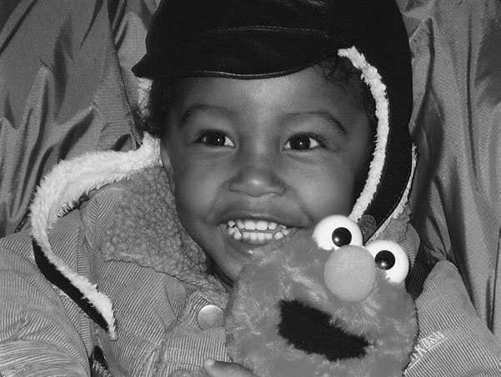The No Cry Discipline Solution (41 page)
Read The No Cry Discipline Solution Online
Authors: Elizabeth Pantley

When your anger controls your words and actions, what follows
will be unpleasant and ineffective. You will
not
teach your child what you intend to teach. He or she will not hear the meanings of
your words—instead your child will be mired in your anger. Your

170
A Peaceful Home: Staying Calm and Avoiding Anger
Spencer, age 2
child’s focus will be your anger, not whatever point you are trying
to make. If you stop and wait, however, you can make your point
and teach a better lesson. When you are calm and in control you
can be rational and achieve the goal you are setting out for.
It’s a fact of life that you are going to get upset, annoyed, and
frustrated with your child, and you are going to raise your voice.
A short burst of unhappiness that quickly dissipates is not an issue
to be concerned with. However, the minute you no longer feel in
control of your words or actions, the situation begins to go down-
hill fast and all hope of teaching is lost.
As you sense your control slipping—STOP. If you are in the
middle of a sentence—STOP—don’t even fi nish your thought,
except perhaps to say, “I’m getting mad!” If you are moving—STOP
moving. Practice a STOP gesture that can be used as a way to put a
Having a Plan to Manage Your Anger
171
physical brake on your emotions, and also as a signal to your child
that your anger is rising out of control. A good STOP gesture is to
hold your hands up in front of your face, fi ngers straight up, palms
out. Push the anger away from you, and at the same time say the
word
stop
. You can say it loudly and fi rmly. Combining the action and the word has two purposes. It is a physical motion to help you
halt your actions, and it is directed at your child to let him know
you are too angry to continue.
This stop is for
you
. It is not intended to stop your child’s actions because it most likely will not stop your child’s misbehavior. Your
yelling child may continue to yell. Your tantruming child might
continue to tantrum. Your bickering children might continue to
bicker. The theory here is that you must get yourself calmed down
in order to deal with your child’s misbehavior. If you are lucky, over
time, this may begin to stop your child’s action as well. He or she
may learn that once you stop there is no point in continuing, since
you will be disengaged.
I recommend that you talk to your child about this in advance.
Let him know what your new plan will be. It might sound some-
thing like this: “Mommy doesn’t like to yell and get mad. So when
I get upset I’m going to put my hands up like this and I am going
to say ‘STOP!’ This means that I am getting mad and I need to
stop talking and calm down.” Demonstrate what you will do with
your hands as you say this. There are two advantages to explaining
your plan in advance. First, your child will know what to expect
and why you’re doing it, so you won’t catch him off guard. Second,
it shows him a productive way to handle his own anger.
Releasing Your Anger—but Not at Your Child
What if you are so angry at your child that you are ready to
strike him and you cannot fi nd the restraint to use your STOP
gesture? In that case, channel your physical reaction into a burst
of applause. Granted, it won’t be happy applause. When you feel





172
A Peaceful Home: Staying Calm and Avoiding Anger
Mother-Speak
“ We use a silent scream in our house to release anger. It is
just like a full-throated regular scream with screwed-up face
and eyes, wide-open mouth, clenched fi sts, and a tight
and vibrating body—just without the sound. I’ve taught my
daughters how to use it when they get angry. After a par-
ticularly busy and frustrating morning, my daughter Willow
suggested that I use one as I grumbled at the traffi c. It was
fabulous. Although I think the other drivers might’ve thought
I was crazy, it saved me from losing my temper!”
—Jane, mother to Isla, age 5, and Willow, age 4
yourself about to strike, clap your hands. Clap them hard and fast,
while you express your feelings of anger. Try it now. Pretend you’re
angry, clap your hands, and tell your imaginary child how you feel.
(“OH! I am so angry right now!!”) You’ll fi nd that in addition to
releasing your pent-up anger, clapping will send a very clear mes-
sage to your child.
When to STOP
This anger management technique of acknowledging anger and
stopping yourself can be used for all problems. It can be effective
with everything from minor irritations that bring irrational anger
to major problems that require a clear head to solve. The time
frame on this step can be anywhere from a few minutes to a day or
more, depending on how upset you are and how big the problem is
that you must deal with—and how quickly your must address the
issue with a solution.
To recap, once you sense that you are losing control use your
STOP gesture and words to halt the evolution of anger.



